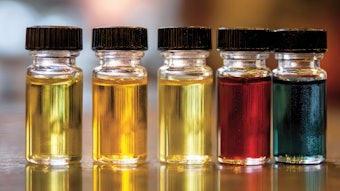The objectives of this paper on Armoise (Artemesia Herb. Alba) are to
--Identify growing areas --Determine the effect of growing areas on oil constitution --Contribute to the existing knowledge of components of the oil --Suggest a typical oil quality as used intemationafly in the fragrance industry --Contribute to an understanding of the influence of climate on oil constitution
Although Artemesia Herba Alba has been used in fragrances for over fifty years, characterization of the oil has, to the best of our knowledge, only recently received attention. This is doubtless due to the increased awareness of its growing importance in modern fragrances. Since this botanical is not cultivated, it presents difficulty in determining what may be typical or consistent in quality; the thujone-camphor ratio, especially, is known to vary over a very wide range in commercial production. Recognizing, therefore, that component identification-delineation and overall constitution must be related to an understanding of the agricultural aspects of armoise, a concept that is a combination of chemical analysis and agricultural considerations will be presented.
According to an excellent and detailed study by Benjilali and Richard, the beta thujone content of armoise ranges from 1% to 84%; the alpba thujone varies from 2.2% to 74%; camphor ranges from 5% to 69%. The combination of these three may total 62% to 98% of the oil. The question then is what is “typical” and congruent with the needs of the fragrance industry? This is summarized in Table I. Table II lists eighteen compounds, sixteen of which are identified with certainty. As far as we know, these are all the compounds thus far reported. The sesquiterpenes, beta-guaiene, and gamma-elemene were given tentative identification. Up to this point we have not been able to support the identification of gamma-elemene and beta-guaiene. Figure 1 is a survey gas chromatogram of a typical oil.










